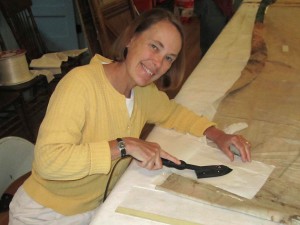 Working with Washi
Working with Washi
Paper Conservation of
Paper-Based Collections
I have worked in the field of conservation for the past twenty-two years, and my area of specialty is paper conservation and preventive conservation for cultural institution. Since the beginning of my private business in 1995, I have treated over 1,500 artifacts ranging from 18th century engravings to ski posters from the 1930’s. In addition, I have developed and presented many workshops related to the care of museum collections such as “Emergency Response and Salvage Methods”, “Storage for 3-Dimensional Artifacts”, “Environmental Monitoring for Museums”, “Care of Family Treasures”, just to mention a few.
I am a Professional Associate (PA) of the American Institute for Conservation of Historic and Artistic Works (AIC) and have been an active member since 1989. As a PA, I follow the code of ethics established by AIC in my private practice. The code of ethics is available for client review at: www.conservation-us.org.
Protocols for Treatment:
There are several steps necessary for the safe treatment of artworks on paper. First, the conservator will carry out a physical examination of the artwork and a Technical Examination will be written. This report will cover the present condition of the artwork, a discussion of the physical components and attributes, a list of the treatment limitations and a paragraph on the anticipated results of the proposed treatment.
A Treatment Proposal will be designed specifically to the needs of the examined artwork. The treatment steps and protocols will be discussed step-by-step. A disclaimer will be at the end of this document and the client and the conservator will both sign-off on the treatment. A set price for the treatment will be given to the client at this time as an estimate for the work to be carried out.
Prior to treatment, the present condition of the artwork will be documented with Photo Documentation using digital photography. This will include before treatment shots of the front and back of the artwork and details of significant damage. If necessary during treatment images will be taken before inpainting or major tear repair. After treatment, the same procedure will be carried out and the images will be stored indefinitely by the conservator as part of the treatment record. If requested, black and white photography is available as well as professional reproduction of your artwork or document through the services of nationally known photographer Fletcher Manley. www.fletchermanley.com
To complete the treatment process, a final report will be generated based on the agreed upon Treatment Proposal. The final Treatment Report will list all the materials used in each treatment step and will include any additional information that the conservator has found such as an artist’s signature on the verso of a print previously mounted, areas of sensitive media, or the location of a watermark within the primary support. The final report will be signed and dated by the conservator, a copy kept in the permanent record in the lab and a copy presented to the client for their records.
Once treatment is completed, long-term preservation can be insured with proper rehousing of your document, artwork, or large map. Mary Richardson is my in-house framer and we use only 100% cotton rag matboard, archival corrugated paper board and UV filtering glass when framing. Mary has an extensive background in box making and custom made storage systems can be fabricated for your artifacts. Please go to Additional Services for more detailed information.
Finally, an invoice for the agreed upon price stated in the Treatment Proposal will be submitted and payment is required upon the return of the client’s artwork. The only time the treatment will cost more is if extenuating circumstances (such as complications during a backing removal) will require more time. If this is the case, the treatment will be stopped and the client contacted to discuss next steps as well as the financial costs. Most proposals for work, plan for a “worst case scenario” and if the project takes substantially less time, the cost for the treatment will be adjusted accordingly.
